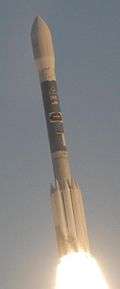Delta 4000
 Launch of a Delta 4925 | |
| Function | Launch vehicle |
|---|---|
| Manufacturer | McDonnell Douglas |
| Country of origin | United States |
| Cost per launch | US$34.22 million in 1985 (4925 variant)[1] (US$79.99 million in 2018) |
| Size | |
| Height | 34 m (112 ft) |
| Diameter | 2.44 m (8 ft 0 in) |
| Mass | 200,740 kg (442,560 lb) |
| Stages | 2 or 3 |
| Capacity | |
| Payload to LEO | 3,400 kg (7,500 lb) |
| Payload to GTO | 1,200 kg (2,600 lb) |
| Associated rockets | |
| Family | Delta |
| Comparable | Delta 5000, Delta II |
| Launch history | |
| Status | Retired |
| Launch sites |
Cape Canaveral SLC-17 Vandenberg AFB SLC-2W |
| Total launches | 2 |
| Successes | 2 |
| First flight | 28 August 1989 |
| Last flight | 12 June 1990 |
| Boosters – Castor 4A | |
| No. boosters | 9 |
| Length | 9.12 m (29.9 ft) |
| Diameter | 1.02 m (3 ft 4 in) |
| Empty mass | 1,529 kg (3,371 lb) |
| Gross mass | 11,743 kg (25,889 lb) |
| Motor | Solid |
| Thrust | 478.3 kN (107,500 lbf) |
| Specific impulse |
|
| Burn time | 56 s |
| First stage – Thor/Delta ELT | |
| Length | 22.4 m (73 ft) |
| Diameter | 2.44 m (8 ft 0 in) |
| Empty mass | 4,059 kg (8,949 lb) |
| Gross mass | 84,067 kg (185,336 lb) |
| Engines | 1 MB-3 |
| Thrust | 760.6 kN (171,000 lbf) |
| Specific impulse |
|
| Burn time | 222 s |
| Fuel | LOX/RP-1 |
| Second stage – Delta K | |
| Length | 5.89 m (19.3 ft) |
| Diameter | 2.44 m (8 ft 0 in) |
| Empty mass | 950 kg (2,090 lb) |
| Gross mass | 6,954 kg (15,331 lb) |
| Engines | 1 AJ10-118K |
| Thrust | 43.6 kN (9,800 lbf) |
| Specific impulse | 319 s |
| Burn time | 431 s |
| Fuel | N2O4/Aerozine 50 |
| Third stage – PAM-D (optional) | |
| Length | 2.03 m (6 ft 8 in) |
| Diameter | 1.25 m (4 ft 1 in) |
| Empty mass | 128 kg (282 lb) |
| Gross mass | 2,137 kg (4,711 lb) |
| Motor | Star 48B |
| Thrust | 66 kN (15,000 lbf) |
| Specific impulse | 286 s |
| Burn time | 87 s |
The Delta 4000 series was an American expendable launch system which was used to conduct two orbital launches in 1989 and 1990. It was a member of the Delta family of rockets. Although several variants were put forward, only the Delta 4925 was launched. The designations used a four digit numerical code to store information on the configuration of the rocket. It was built from a combination of spare parts left over from earlier Delta rockets, which were being retired, and parts from the Delta II 6000-series, which was just entering service.
The first stage was the MB-3-III powered Extended Long Tank Thor, previously flown on the 1000-series. Nine Castor-4A solid rocket boosters were attached to increase thrust at lift-off, replacing the less powerful Castor-4 boosters used on the 3000 series. The Delta-K was used as a second stage. A Star-48B PAM-D was used as a third stage, to boost payloads into geosynchronous transfer orbit.
Both Delta 4000 launches occurred from Launch Complex 17B at Cape Canaveral. The first launched Marco Polo 1 for BSkyB, and the second launched INSAT 1D for the Indian Space Research Organisation. Both were successful.
References
- Wade, Mark. "Delta". Encyclopedia Astronautica. Archived from the original on 2008-07-24. Retrieved 2009-02-15.
- Krebs, Gunter. "Thor family". Gunter's Space Page. Retrieved 2009-02-15.
- Wade, Mark. "Delta 4000". Encyclopedia Astronautica. Retrieved 2018-09-08.
- ↑ "Delta 4000". Retrieved September 8, 2018.
